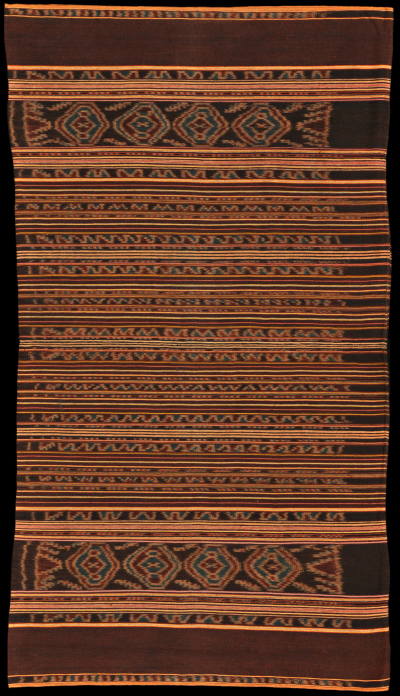| |
 
 | | | |
130 Solor Archipelago, Adonara
Kewatek (sarong)  
| | Locale: | Village unknown. Lamaholot people. | | Period: | Late 19th to early 20th C. | | Yarn: | Cotton, hand-spun, medium, and silk | | Technique: | Warp ikat | | Panels: | 2 | | Size: | 70 x 125 cm (2' 3" x 4' 1") LW: 1.79 | | Weight: | 520 g (18.3 oz), 297 g/m2 (0.97 oz/ft2) | | Design: | Ceremonial or festive sarong for woman of high status, made in mowak kiwane - ikat using traditional materials only. Wide and narrow bands of morinda red and indigo, with snaking geometrical design, reminiscences of patola motifs such as tumpal and jilamprang. Garnished with very narrow stripes (most only two threads wide) in brighter trade yarn, probably silk, which was available in eastern Nusa Tenggara from the 19th c. up until World War II. | | Comment: | One of the most elaborately decorated old Adonara textiles known, almost certainly woven for royalty. Extremely rare, only four other pieces of comparable age and quality known to be extant, including our PC 284. All natural dies, except the silk garnishing. Overall tonality brown and golden. Very attractive sarong showing its age and its use as a pusaka, but in excellent condition. | | Background: | Chapters on Solor Archipelago and Adonara. | | Exhibited: | Museu do Oriente, Lisbon, 2014/15.
Hong Kong University Museum and Art Gallery, 2017. | | Published: |
Woven Languages, 2014.
Ikat Textiles of the Indonesian Archipelago, 2018.
| | Compare: | 284 355 | | Sources: | Similar to kewatek in Art Institute of Chicago, Bakwin Collection, No. 2002.1001, though more ornate. Very similar to dowry kewatek in Barnes, Ostindonesien im 20. Jahrhundert, Auf den Spuren der Sammlung Vatter, Abb. 189; and to another one in Barnes & Kahlenberg, Five Centuries of Indonesian Textiles, Plate 97. As Barnes writes, Ernst Vatter in 1929 thought that the few pieces he saw must have been woven on another island, but Barnes is firm that such pieces were indeed woven on Adonara island, in coastal villages such as Tanah Boleng. As she indicates 'Heute sind diese Sarong sehr selten.' ('Nowadays such sarongs are very rare.') We believe that these sarongs, or at least the skeins of warp containing the main ikated motifs were made in Ili Api on Lembata. See for instance the likeness of the motifs to those on PC 131. | | |

©Peter ten Hoopen, 2025
All rights reserved.
|
|


